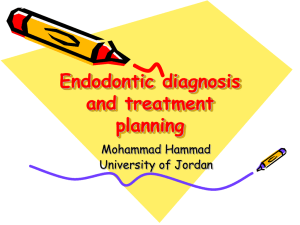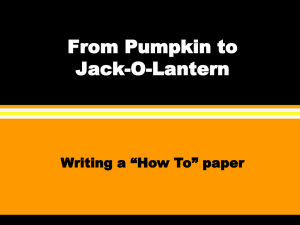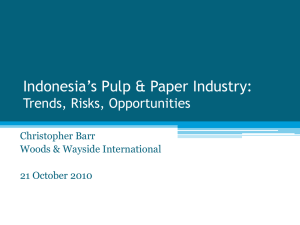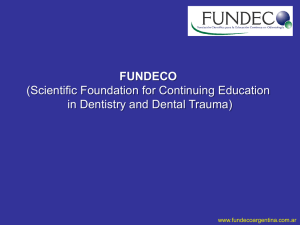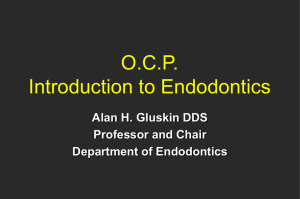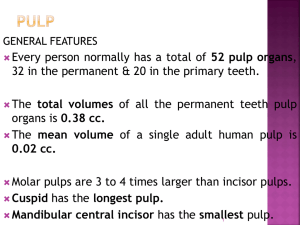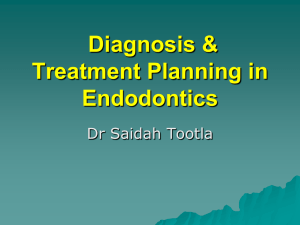的根管治疗 - shabeelpn
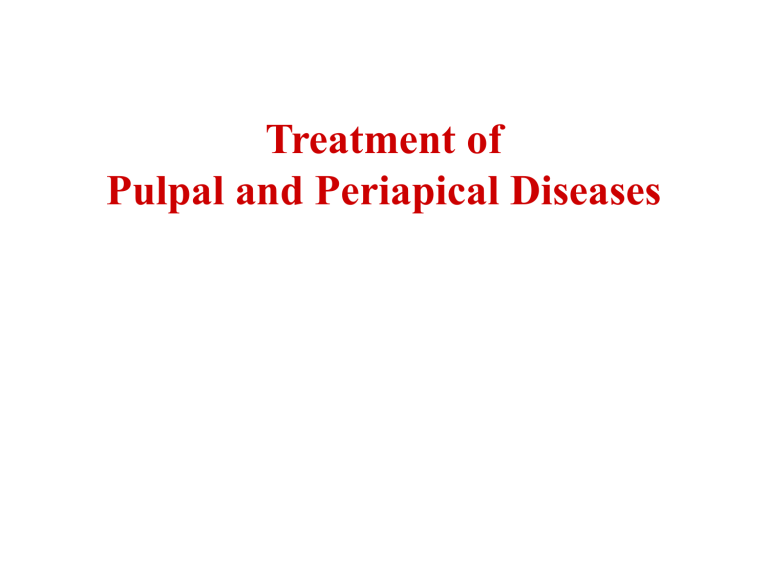
Treatment of
Pulpal and Periapical Diseases
1. Case Selection and Treatment Planning
病例选择与治疗计划
Pathways of the pulp, 8 th edition
Chapter Outline
• Common medical findings that may influence endodontics
• Dental evaluation
• Treatment planning
1.1 Common medical findings that may influence endodontics
1.1.1 Pregnancy
• Not a contradiction to endodontics
• Modified treatment plan
– Defer elective dental treatment during the first trimester except emergency treatment
– Provide routine dental care during the second trimester
– Consult physician if necessary
1.1.2 Cardiovascular disease
• Medically compromised patients
• Consult with physicians before initiation of treatment
Myocardial infarction 心肌梗死
(heart attack) within past 6 months
• Increased susceptibility to repeat infarctions and other cardiovascular complications
•
Contraindication to any elective dental care
Patients with a history of
– Heart murmur 心脏杂音
– Mitral valve prolapse with regurgitation 二尖瓣回流
– Rheumatic fever 风心病
– Congenital heart defect 先心病
– Artificial heart valves 人工瓣膜
• Increased susceptibility to infective (bacterial) endocarditis 细菌性心内膜炎
•
Potentially fatal complication
•
Prophylactic antibiotic therapy
预防性使用抗生素
Coronary artery bypass graft
• Antibiotic prophylaxis is not needed after the first few months of recovery
• Consultation is advised
1.1.3 Cancer
Patients undergoing chemotherapy and/or radiation to the head and neck
• Impaired healing responses
• Consult the patient’s physician before initiation of treatment
1.1.4 AIDS
•
Infection control
• Asymptomatic patients are usually candidates for endodontic treatment
•
Medical consultation before endodontic surgery for HIV-infected patients
1.1.5 Diabetes
• Well controlled patients are candidates for endodontic treatment
•
Medical consultation for patients with serious complications or before endodontic surgery
– Renal disease
– Hypertension
– Coronary atherosclerotic disease
冠状动脉粥样硬化
1.1.6 Dialysis
透 析
• Bleeding tendency
•
Elective endodontic treatment should be postponed
1.1.7 Prosthetic implants
– Heart valves
– Vascular grafts
– Pacemakers 起搏器
– Cerebrospinal fluid shunts
– Prosthetic joints 人工关节
•
Antibiotic prophylaxis to prevent infection at the site of the prosthesis
•
Medical consultation highly recommended
1.1.8 Behavioral and psychiatric disorders
Consultation before using
• Sedatives 镇静剂
• Hypnotics 催眠药
• Antihistamines 抗组胺药
1.2 Dental evaluation
•
Periodontal considerations
•
Restorative considerations
•
Endodontic considerations
•
Surgical considerations
1.2.1 Periodontal considerations
• Periodontal probing
• Mobility assessment
• Radiographic assessment
•
Endodontic treatment should not be planned for teeth with poor periodontal prognosis (e.g. mobility III)
1.2.2 Restorative considerations
•
Restorative treatment planning before starting endodontic treatment in a nonemergency situation
– Extensive loss of tooth structure
– Subosseous root caries (crown lengthening may be needed)
– Poor crown-root ratio
– Lack of ferrule effect
– Misaligned tooth
• Consultation with a prosthodontist
1.2.3 Endodontic considerations
– Anatomy of roots and canals
– Procedural errors
– Small mouth
– Instruments
– Operator skill
– Time
•
To determine the level of anticipated difficulty
• To identify cases that should be referred
1.2.4 Surgical considerations
• Of particular value in the diagnosis of nonodontogenic lesions
• Biopsy prior to definitive endodontic treatment
1.3 Treatment planning
Scope of endodontics
• Vital pulp therapy 活髓保存
•
Pulpectomy or RCT 牙髓摘除术或根管治疗
• Endodontic surgery 牙髓外科
•
Retreatment 再处理
• Hemisection or root amputation 牙半切或截根术
•
Bleaching 牙漂白
•
Apexification or apexogenesis
根尖发育成形术或根尖诱导术
Treatment planning
• Treatment or extraction?
• What kind of treatment ?
– Endodontic
– Periodontal
– Restorative
• Who will be the operator?
• Single-visit or multi-visit?
• Cost
• Prognosis
2. Preparation for treatment
• Infection control
– Universal precautions
(operatory preparation)
– Instrument sterilization
– Tooth isolation 患牙隔离
• Patient preparation
– Informed consent 知情同意
– Pain control
2.1 Infection Control
• Dental personnel are at risk of exposure to a host of infectious organisms
• Risk of cross-contamination in the dental environment
Effective infection control procedures
• Reduce the number of micro-organisms in the working environment
• Protect patients and the dental team
• Improve the outcome of endodontic treatment
Universal precautions
• American Dental Association (ADA) recommendation
•
Each patient is considered potentially infectious
•
The same strict infection control policies applied to all patients
Infection control guidelines
•
Dental personnel vaccinated against hepatitis B
•
Thorough and updated patient medical history
• Proper barrier techniques for dental personnel
– Masks, protective eyewear, disposable latex gloves
– Hands, wrists and lower forearms washed with soap
–
Use of vacuum suction (high-volume evacuation) for high-speed handpiece, water spray or ultrasonics
–
Use of rubber dam
Cross-contamination related with handpieces
• Surface contamination 表面污染
• Air contamination 空气污染
• Suction contamination 回吸污染
Rubber Dam
橡皮障
Routine placement of the rubber dam is considered the standard of care in USA
Reasons for use of rubber dam
•
Protection
– aspiration or swallowing of instruments or irrigants
– Soft tissue injury caused by instruments
•
Efficiency
– Improve visibility (dry field and reduced mirror fogging)
– Minimize patient conversation
– Minimize the need for frequent rinsing
•
Reduced risk of cross-contamination
•
Legal considerations
Components of rubber dam system
•
Rubber dam (sheet) 橡皮障
•
Frame 橡皮障架
•
Retainers (clamps) 橡皮障夹
•
Punch 橡皮障打孔器
•
Forceps 橡皮障钳
2.2 Informed consent
• Continuous rise in dental litigation
• For consent to be informed
– The procedure and prognosis must be described
– Alternatives to the recommended treatment must be presented along with their respective prognoses
– Foreseeable risks must be described
– Patients must have the opportunity to have questions answered
根管治疗知情同意书
请阅读以下同意书,若您同意下列内容,请在治疗开始前签字。
本人因诊断为_____________, 同意授权_________医生进行________的根
管治疗(镍钛机动预备/手动预备,热牙胶充填/冷侧压充填)。同时我也同意
上述医生在他(她)认为必要 (或按治疗计划认为必要) 的情况下照X线片,使
用药物治疗、麻醉以及相关设备或处理措施。
本人已充分理解根管治疗是保留患牙的最佳治疗方法。完善的根管治疗较
其它牙髓治疗难度大、费时,需要精良的器械和技术,费用也较高。根管治疗
需要去除牙内感染的牙髓组织(含血管、神经),然后用充填材料封闭根管。
根管治疗成功率较高。但少数患牙因牙齿本身的情况较复杂,也可能需要再处
理、根尖周手术甚至被拔除;在治疗过程中,可能出现器械折断于根管内、根
管壁侧穿或髓底穿以及牙体折裂。治疗之后,患牙通常需要以桩核或全冠修复
来保护和恢复患牙功能,否则易发生牙体折裂。
根管治疗与麻醉的常见并发症包括:疼痛、肿胀、牙关紧闭、感染、出血
以及唇、牙龈或舌的麻木,但麻木极少持续。
我已了解了根管治疗的情况, 就诊医生已向我介绍了根管治疗(镍钛机动
预备/手动预备,热牙胶充填/冷侧压充填等)具体步骤及相应特点。我的疑问
也已从就诊医生处得到满意的回答。
本人同意医生采用_____________________________ _______治疗方案,
具体治疗费用约________元。
患者姓名: ____________ 时间:____________
患者签名(若患者为未成年人则由监护人代签): ____________
主诊医生签名:____________ 时间:____________
2.3 Pain control
•
Local anesthesia
•
Divitalization 失活法
2.3.1 Local anesthesia (LA)
• When to anesthetize
– LA should be given at each appointment
• Three misconceptions
– Necrotic teeth may be instrumented without LA
(vital tissue may exists periapically)
– Patient’s sense aids the clinician to determine working length 根管工作长度
– LA is unnecessary during obturation phase
(obturation pressure and extrusion of sealer may produce pain)
local anesthetics
Lidocaine 利多卡因
Articaine 阿替卡因
碧兰麻
( 阿替卡因 )
Techniques
• Conventional techniques
–
Supraperiosteal injection (local infiltration)
–
Regional nerve block
• Supplemental techniques
– Periodontal ligament (PDL) injection
– Intrapulpal injection
– Intraseptal injection
– Intraosseous (IO) injection
• Maxillary posterior teeth
– Posterior superior alveolar (PSA) block for molars
– Buccal infiltration for premolars
– Palatal infiltration for rubber dam retainer
(optional)
• Maxillary anterior teeth
– Labial infiltration
– Palatal anesthsia for rubber dam retainer
(optional)
• Mandibular teeth
– Inferior alveolar nerve (IAN) block for anterior and posterior teeth
– Incisive nerve block for premolars and anterior teeth
– Labial infiltration for anterior teeth
Periodontal ligment (PDL) injection
• 27-gauge/short or 30-gauge/ultrashort needle
• Placed into the periodontal space between the root and the interseptal bone
• Bevel facing the root
• 0.2mL of anesthetic slowly deposited on the distal of each root of the tooth
• Index of successful PDL injection
– Presence of resistance to anesthetic deposition
– Ischemia of the soft tissue at the site of injection
•
Contraindications
– Presence of infection or inflammation in the area of needle insertion (e.g. acute apical abscess)
Intrapulpal injection
• 27-gauge/short needle
• Inserted into the pulp chamber or canal
• Resistance met and 0.2~0.3mL of the solution expressed
• In lack of a snug fit of the needle
– warm gutta percha 牙胶 inserted around the needle
– Injection under pressure after cooling
2.3.2 失活法
Devitalization
– 用化学药物封于牙髓创面上,引起牙髓血运
障碍而使牙髓组织坏死失去活力,以达到无
痛操作
– 使牙髓失活的药物称为失活剂
失活 法可以有效地达到无痛操作,常规用于
干髓治疗。其他去髓治疗在麻醉效果不佳,
或对麻醉剂过敏时才采用失活法
常用失活剂
• 多聚甲醛
(三聚甲醛,简称“三甲”)
– 引起牙髓血运障碍而发生坏死
– 毒性弱于亚砷酸较安全
– 作用相对缓慢
– 封药时间:全牙髓 14 天
根髓 7-10 天
常用失活剂
• 亚砷酸( As
2
O
3
)
– 毒性强:细胞原生质、神经、
血管
– 作用迅速:牙髓血运的影响
– 无自限性:化学性根尖周炎
– 严格控制封药时间: 24-48 小时
– 禁用于根尖孔未形成的患牙
操作步骤
• 告知患者:选择失活剂、按时复诊
• 暴露牙髓:不强调彻底去腐
• 减压引流、控制出血:酚、肾上腺素棉球
• 放置失活剂:小球钻大小 + 丁香油棉球
• ZOE 暂封窝洞
失活法
– 增加就诊次数
– 牙体变色
适用于后牙
– 失活不全
麻醉法
– 缩短疗程
– 适用于全口牙
– 作用迅速完全
3. Vital Pulp Therapy
活髓保存治疗
•
Indirect pulp capping 间接盖髓术
•
Direct pulp capping 直接盖髓术
•
Pulpotomy 牙髓切断术
“ Principles and practice of endodontics”
2th edition
3.1 Indirect pulp capping
Indications
– deep carious lesions
– No history of pulpalgia
– No signs of irreversible pulpitis
– No pulp exposure after excavation of carious dentine
Pulp Capping Materials
Calcium hydroxide 氢氧化钙
• The most commonly-used
(direct) pulp-capping material
– Water-based calcium hydroxide
– Resin-based Calcium hydroxide e.g. Dycal, Timeline
Zinc oxide-eugenol cement (ZnOE)
•Only for indirect pulp capping
•Bactericidal effect and hermetic marginal seal
•Cytotoxicity-use of ZnOE as a liner in deep carious lesions is still controversial
Procedures
1. Remove all softened, mushy or leathery dentine
2. Either ZOE or Ca(OH)
2 placed on the remaining dentin to kill or suppress bacteria
3. Base
4. Temporary or permanent restoration
3.2 Direct pulp capping
Indications:
• Accidental or mechanical pulp exposure
(normal pulp)
– Cavity preparation
– Placement of pins
– Trauma
•
Mainly for immature permanent teeth with recent (<24 hr) traumatic pulp exposure or mechanical exposure during cavity preparation
Should mature teeth be pulp capped?
•Size of exposure limited to 1mm
•Contraindicated for carious tooth with pulp involvement
Enamel-dentin fracture with pulpal involvement
Direct pulp capping
Hemostatic reagents
止血剂
•
Saline 盐水
• Hydrogen peroxide 双氧水
•
Diluted sodium hypochlorite 次氯酸钠
• Chlorhexidine 洗必泰
Pulp capping materials
•
Calcium hydroxide
•
Mineral trioxide aggregates (MTA)
矿化三氧化聚合物
Procedures
1. Ca(OH)
2 applied to the exposure to stimulate differentiation of new odontoblast-like cells and formation of secondary dentin
2. Temporary restoration placed over Ca(OH)
2
3. Follow-up
4. Permanent restoration
5. Pulpotomy or endodontic treatment for symptomatic tooth
3.3 pulpotomy
Indication:
Immature permanent teeth
Procedures
• Removal of all carious dentin and pulp tissue to the level of the radicular pulp
• Vital pulp stump capped with Ca(OH)
2
• Temporary restoration
• Follow-up
• Asymptomatic: permanent restoration
• Symptomatic: endodontic treatment
Potential problems with pulpotomy as a permanent treatment
• Impossible to determine whether all disease tissue has been removed
• The remaining radicular pulp tissue may undergo mineralization
– Making further endodontic treatment difficult or impossible
• Internal resorption
Conclusions
• The vital pulp therapies are predictable in teeth with traumatic or mechanical pulp exposure.
•
Direct pulp capping is contraindicated for teeth with carious pulp exposure. Pulpotomy might be the choice but is considered unproven.
• When – for financial or other reasons – extraction is the only alternative, pulpotomy certainly should be considered for the benefit of the patient.
4. Emergency Treatment
Pretreatment emergency
• Irreversible pulpitis without acute apical periodontitis
• Irreversible pulpitis with acute apical periodontitis
• Pulp necrosis with acute apical periodontitis
Pathways of the pulp, 8 th edition
Principles and practice of endodontics, 2 th edition
4.1 Irreversible pulpitis without AAP
Principles:
• Complete pulp removal
• Total cleaning and shaping (C/S) of the root canal system 根管清理和成形
• Pulpectomy is the best to achieve pain relief
Pulpectomy
•Complete removal of the vital pulp tissue followed by cleaning , shaping and filling of the root canal(s).
•Indicated for tooth with pulpitis
• Multirooted teeth at the emergency visit
– Pulpotomy (removal of the coronal pulp) or patial pulpotomy (removal of the pulp from the widest canal) acceptable but less predictable in pain relief
Procedure
• C/S of the root canal system
• A dry cotton pellet placed in the pulp chamber
•
Complete caries removal and effective temporary coronal seal to prevent contamination
• Occlusal reduction 咬合调整
4.2 Irreversible pulpitis with AAP
Combination of pulpal and periapical symptoms
• Complete pulp removal and C/S
• Ca(OH)
2 medication in canals to prevent bacterial regrowth
• Effective temporary coronal seal
• Occlusal reduction
• Oral analgesic medication when necessary
4.3 Pulp necrosis with AAP
•
Without swelling
•
With localized swelling
•
With diffuse swelling
Without swelling
• Thorough removal of necrotic pulp
• Complete C/S of the root canal
– Introducing a small file (#10/15) slightly beyond the apex to establish drainage from the periapical tissues
• Ca(OH)
2 dressing between visits to help eliminate remaining bacteria
• Oral analgesics
With swelling
•
Principle: debridement 清理 and drainage
• Three ways to resolve swelling and infection
– Drainage through the root canal
– Drainage by incising a fluctuant swelling (incision and drainage, I&D)
– Antibiotic treatment
Localized swelling
Firstly try to establish drainage from root canals
• C/S of the root canal
– Introducing a small file (size 10/15) slightly beyond the apex to establish drainage
– No I&D in case of good drainage
• Ca(OH)
2 medication
• Access seal
– If pus continues to drain through the canal and cannot be dried within a reasonable period of time, the tooth may be left open for <24 hrs
Incision and drainage
• Indicated for localized fluctuant soft tissue swelling
•
Principles
– Incise at the site of the greatest fluctuance
– Dissect gently and extend to the roots
– Keep wound clean with hot saltwater mouth rinses or CHX mouth rinse
Diffuse swelling
• Possible to turn into a medical emergency and lifethreatening condition
•
Principles
– Thorough C/S of the canals
– Apical patency achieved whenever possible
– Tooth left open
– I&D in the absence of drainage through the canals with a rubber dam drain inserted or sutured (2~3 days)
– Referral to oral surgeons
Antibiotic therapy
• Indicated for patients with
– Diffuse swelling regardless of the establish of drainage
– Spreading infections or systemic signs
• Penicillin (1st choice) or clindamycin or erythromycin + Metronidazole
Endodontic Emergency Treatment
Treatment Postop Med Diagnosis and Symptoms
Irreversible pulpitis
Without AAP Complete C/S
With AAP Complete C/S
Ca(OH)
2 dressing
NSAIDs corticosteroids
NSAIDs corticosteroids
Pulpal necrosis without swelling NSAIDs
With localized swelling
With diffuse swelling
Complete C/S
Ca(OH)
2 dressing
Complete C/S
Ca(OH)
2
I&D dressing
Complete C/S
Ca(OH)
2 dressing
I&D
NSAIDs
NSAIDs antibiotics
